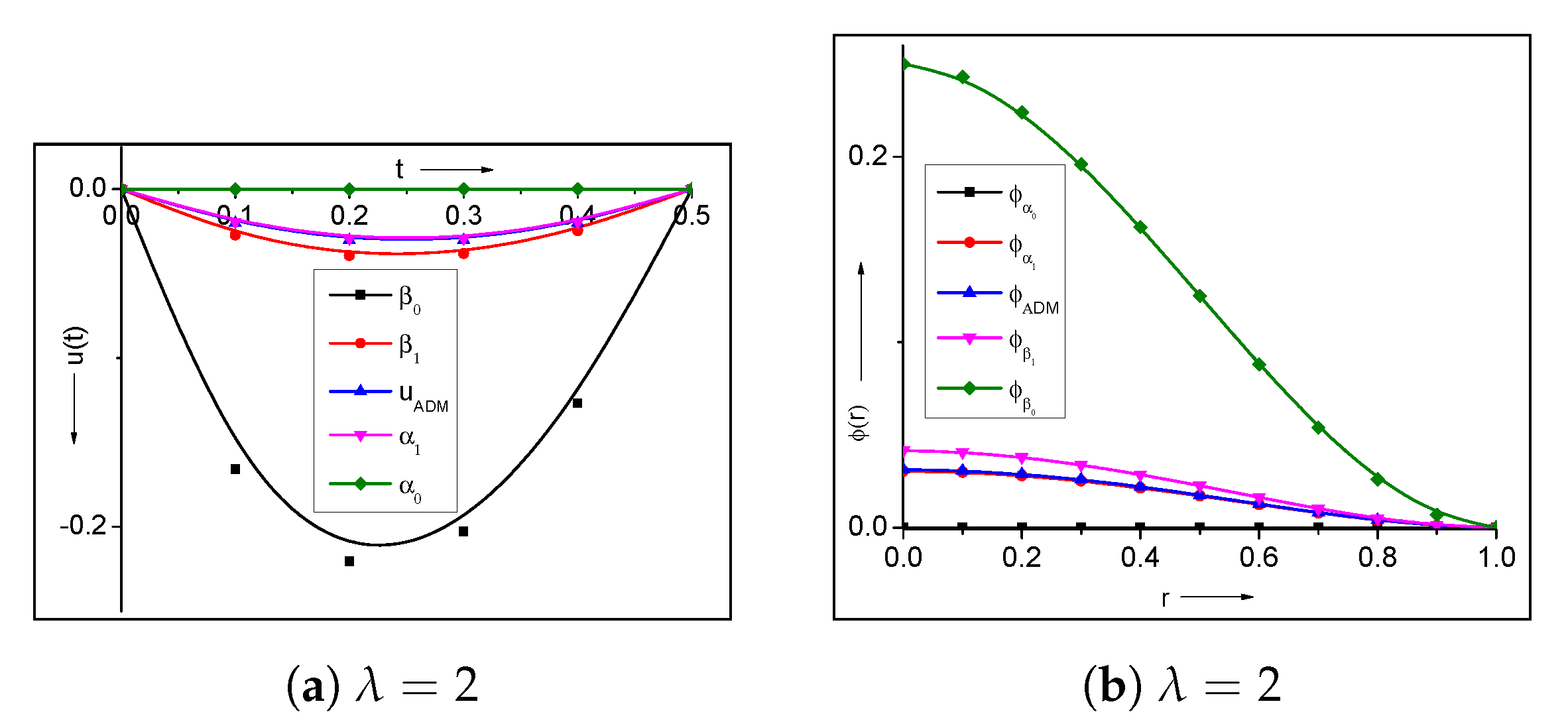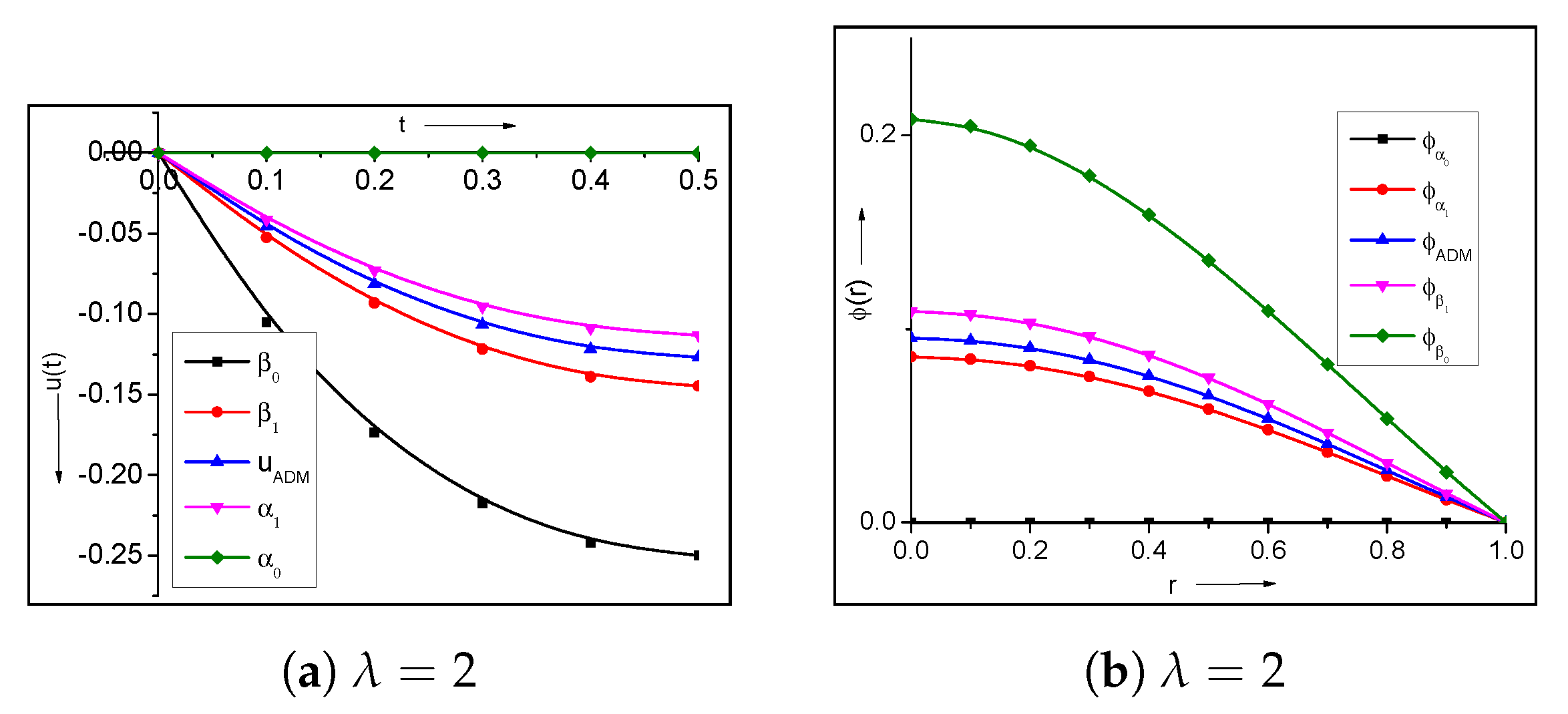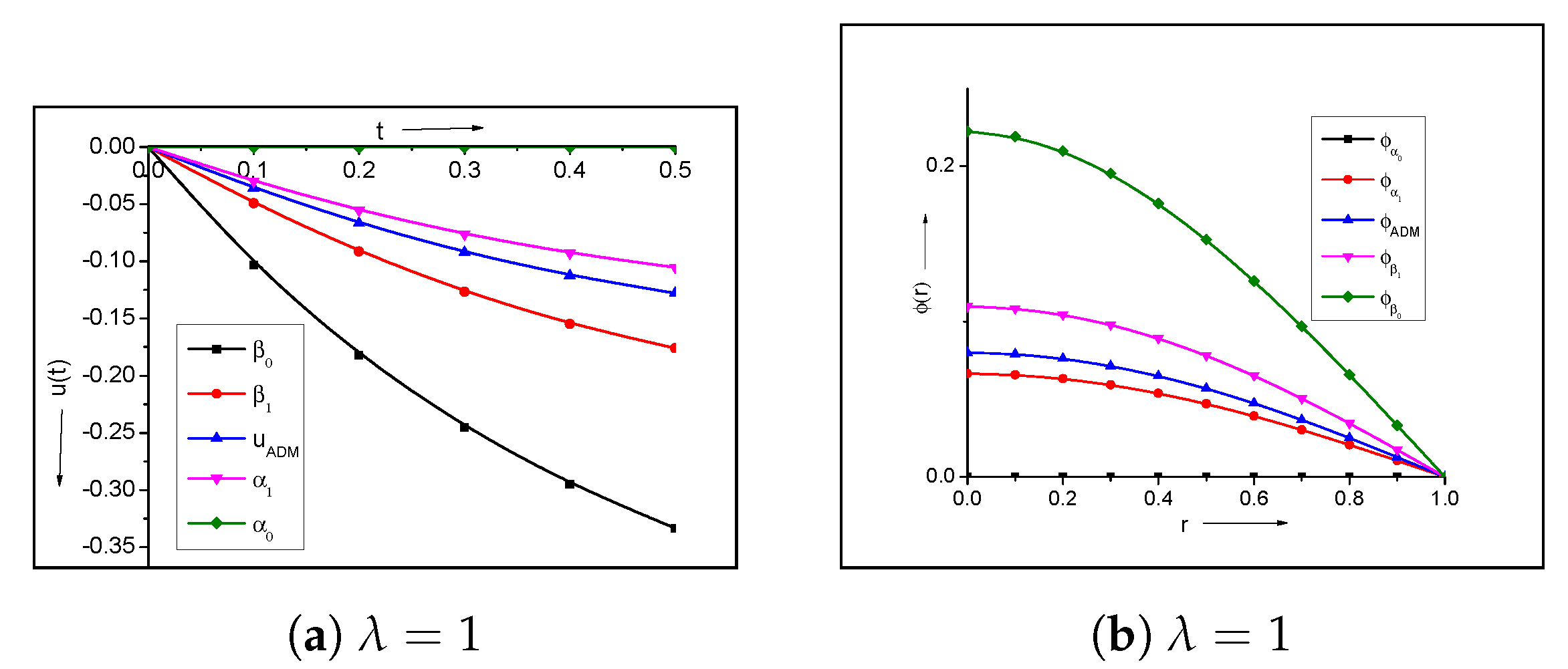Analysis and Computation of Solutions for a Class of Nonlinear SBVPs Arising in Epitaxial Growth
Abstract
1. Introduction
- IE corresponding to Problem 1:
- IE corresponding to Problem 2:
- IE corresponding to Problem 3:
2. Preliminary Work
3. Existence of Solutions
3.1. Construction of Green’s Function
- ;
- ;
- ;
- ;
- .
3.2. Monotone Iterative Technique
- : and satisfiesand
- : is continuous on where
- ,
- ,
- ,.
4. Estimations of
5. Numerical Results and Discussion
5.1. ADM
5.2. Algorithm
5.2.1. Tables
5.3. Monotone Iterative Method
6. Conclusions
Author Contributions
Funding
Institutional Review Board Statement
Informed Consent Statement
Data Availability Statement
Conflicts of Interest
References
- Barabasi, A.L.; Stanley, H.E. Fractal Concepts in Surface Growth; Cambridge University Press: Cambridge, UK, 1995. [Google Scholar]
- Lourdudoss, S.; Kjebon, O. Hybrid vapor phase epitaxy revisited. IEEE J. Sel. Top. Quantum Electron. 1997, 3, 749–767. [Google Scholar] [CrossRef]
- Foord, J.S.; Davies, G.J.; Tsang, W.T. Chemical Beam Epitaxy and Related Techniques; John Wiley and Sons Ltd.: Chichester, UK, 1997. [Google Scholar]
- Escudero, C. Geometric principles of surface growth. Phys. Rev. Lett. 2008, 101, 1–4. [Google Scholar] [CrossRef]
- Escudero, C.; Hakl, R.; Peral, I.; Torres, P.J. On radial stationary solutions to a model of non equilibrium growth. Eur. J. Appl. Math. 2013, 24, 437–453. [Google Scholar] [CrossRef]
- Escudero, C.; Hakl, R.; Peral, I.; Torres, P.J. Existence and nonexistence result for a singular boundary value problem arising in the theory of epitaxial growth. Math. Methods Appl. Sci. 2014, 37, 793–807. [Google Scholar] [CrossRef]
- Escudero, C.; Korutcheva, E. Origins of scaling relations in non equilibrium growth. J. Phys. Math. Theor. 2012, 45, 1–14. [Google Scholar]
- Verma, A.K.; Pandit, B.; Escudero, C. Numerical solutions for a class of singular boundary value problems arising in the theory of epitaxial growth. Eng. Comput. 2019, 37, 2539–2560. [Google Scholar] [CrossRef]
- Verma, A.K.; Pandit, B.; Agarwal, R.P. On approximate stationary radial solutions for a class of boundary value problems arising in epitaxial growth theory. J. Appl. Comput. Mech. 2019, 4, 713–734. [Google Scholar]
- Verma, A.K.; Pandit, B.; Agarwal, R.P. On multiple solutions for a fourth order nonlinear singular boundary value problems arising in epitaxial growth theory. Math. Methods Appl. Sci. 2020. [Google Scholar] [CrossRef]
- Cabada, A.; Cid, J.A.; Sanchez, L. Positivity and lower and upper solutions for fourth order boundary value problems. Nonlinear Anal. 2007, 67, 1599–1612. [Google Scholar] [CrossRef]
- Ladde, G.S.; Lakshmikantham, V.; Vatsala, A.S. Monotone Iterative Techniques for Nonlinear Differential Equations; Pitman Advance Publishing Program: Boston, MA, USA, 1985. [Google Scholar]
- Pandey, R.K.; Verma, A.K. Existence-uniqueness results for a class of singular boundary value problems-ii. J. Math. Anal. Appl. 2008, 338, 1387–1396. [Google Scholar] [CrossRef]
- Pandey, R.K.; Verma, A.K. Existence-uniqueness results for a class of singular boundary value problems arising in physiology. Nonlinear Anal. 2008, 9, 40–52. [Google Scholar] [CrossRef]
- Pandey, R.K.; Verma, A.K. On solvability of derivative dependent doubly singular boundary value problems. J. Appl. Math. Comput. 2010, 33, 489–511. [Google Scholar] [CrossRef]
- Pandey, R.K.; Verma, A.K. Monotone method for singular bvp in the presence of upper and lower solutions. Appl. Math. Comput. 2010, 215, 3860–3867. [Google Scholar] [CrossRef]
- Wang, G.; Agarwal, R.P.; Cabada, A. Existence results and the monotone iterative technique for systems of nonlinear fractional differential equations. Appl. Math. Lett. 2012, 25, 1019–1024. [Google Scholar] [CrossRef]
- Agarwal, R.; O’Regan, D.; Hristova, S. Monotone iterative technique for the initial value problem for differential equations with non-instantaneous impulses. Appl. Math. Comput. 2017, 298, 45–56. [Google Scholar] [CrossRef]
- Xue, T.; Liu, W.; Shen, T. Extremal solutions for p-laplacian boundary value problems with the right-handed riemann-liouville fractional derivative. Math. Methods Appl. Sci. 2019, 42, 4394–4407. [Google Scholar] [CrossRef]
- Mittal, R.C.; Nigam, R. Solution of a class of singular boundary value problems. Numer. Algorithm 2008, 47, 169–179. [Google Scholar] [CrossRef]
- Odibat, Z.; Momani, S. A reliable treatment of homotopy perturbation method for klein-gordon equations. Phys. Lett. A 2007, 365, 351–357. [Google Scholar] [CrossRef]
- Abbasbandy, S. Numerical solutions of the integral equations: Homotopy perturbation method and adomian’s decomposition method. Appl. Math. Comput. 2006, 173, 493–500. [Google Scholar] [CrossRef]
- Babolian, E.; Davari, A. Numerical implementation of adomian decomposition method for linear volterra integral equations of the second kind. Appl. Math. Comput. 2005, 165, 223–227. [Google Scholar] [CrossRef]
- Maleknejad, K.; Hadizadeh, M. A new computational method for volterra-fredholm integral equations. Comput. Math. Appl. 1999, 37, 1–8. [Google Scholar] [CrossRef]
- Abdulaziz, O.; Hashima, I.; Momani, S. Application of homotopy perturbation method to fractional ivps. J. Comput. Appl. Math. 2008, 216, 574–584. [Google Scholar] [CrossRef]
- Hu, Y.; Luo, Y.; Lua, Z. Analytical solution of the linear fractional differential equation by adomian decomposition method. J. Comput. Appl. Math. 2008, 215, 220–229. [Google Scholar] [CrossRef]
- Grzymkowski, R.; Pleszczyński, M.; Słota, D. Comparing the Adomian decomposition methodand the Runge–Kutta method for solutions of theStefan problem. Int. J. Comput. Math. 2006, 83, 409–417. [Google Scholar] [CrossRef]
- Grzymkowski, R.; Słota, D. Stefan problem solved by Adomian decomposition method. Int. J. Comput. Math. 2005, 82, 851–856. [Google Scholar] [CrossRef]
- Grzymkowski, R.; Słota, D. One—Phase Inverse Stefan Problem Solved Adomian Decomposition Method. Comput. Math. Appl. 2006, 51, 33–40. [Google Scholar] [CrossRef][Green Version]
- Grzymkowski, R.; Pleszczyński, M.; Słota, D. The Two-Phase Stefan Problem Solved by the Adomian Decomposition Method. In Proceedings of the 15th IASTED International Conference Applied Simulation and Modelling, Rhodes, Greece, 26–28 June 2006. [Google Scholar]
- Verma, A.K.; Pandit, B.; Agarwal, R.P. Existence and nonexistence results for a class of fourth-order coupled singular boundary value problems arising in the theory of epitaxial growth. Math. Methods Appl. Sci. 2020. [Google Scholar] [CrossRef]
- Hayani, W.A. Adomian decomposition method with green’s function for sixth order boundary value problems. Comput. Math. Appl. 2011, 61, 1567–1575. [Google Scholar] [CrossRef][Green Version]
- Singh, R.; Kumar, J. The adomian decomposition method with green’s function for solving nonlinear singular boundary value problems. J. Appl. Math. Comput. 2014, 44, 397–416. [Google Scholar] [CrossRef]
- Noeiaghdam, S.; Sidorov, D.; Wazwaz, A.M.; Sidorov, N.; Sizikov, V. The Numerical Validation of the Adomian Decomposition Method for Solving Volterra Integral Equation with Discontinuous Kernels Using the CESTAC Method. Mathematics 2021, 9, 260. [Google Scholar] [CrossRef]
- Verma, A.K.; Pandit, B.; Verma, L.; Agarwal, R.P. A review on a class of second order nonlinear singular BVPs. Mathematics 2020, 8, 1045. [Google Scholar] [CrossRef]
- Verma, A.K.; Pandit, B.; Agarwal, R.P. Continuous Galerkin Method and Lane-Emden Equations. Adv. Math. Sci. Appl. 2021, 30, 39–64. [Google Scholar]
- Cabada, A. An overview on the lower and upper solutions method with nonlinear boundary value problem. Bound. Value Probl. 2011, 2011, 893753. [Google Scholar] [CrossRef]
- Ghorbani, A. Beyond adomian polynomials: He polynomials. Chaos Solitons Fractals 2009, 39, 1486–1492. [Google Scholar] [CrossRef]
- Singh, R.; Wazwaz, A.M. An efficient algorithm for solving coupled Lane-Emden boundary value problems in Catalytic diffusion reactions: The homotopy analysis method. Commun. Math. Comput. Chem. 2019, 81, 785–800. [Google Scholar]



| Lower Solution | Upper Solution | |||
|---|---|---|---|---|
| 0 | 0 | |||
| 0 | ||||
| Positive Solution | Negative Solution | |||
|---|---|---|---|---|
| 0.001199979 | ||||
| Lower Solution | Upper Solution | |||
|---|---|---|---|---|
| 0 | 0 | |||
| 0 | ||||
| Positive Solution | Negative Solution | |||
|---|---|---|---|---|
| Lower Solution | Upper Solution | |||
|---|---|---|---|---|
| 0 | 0 | |||
| 0 | 0.000557377 | |||
| Positive Solution | Negative Solution | |||
|---|---|---|---|---|
| 0.000557832 | 0.000562261 | |||
Publisher’s Note: MDPI stays neutral with regard to jurisdictional claims in published maps and institutional affiliations. |
© 2021 by the authors. Licensee MDPI, Basel, Switzerland. This article is an open access article distributed under the terms and conditions of the Creative Commons Attribution (CC BY) license (https://creativecommons.org/licenses/by/4.0/).
Share and Cite
Verma, A.K.; Pandit, B.; Agarwal, R.P. Analysis and Computation of Solutions for a Class of Nonlinear SBVPs Arising in Epitaxial Growth. Mathematics 2021, 9, 774. https://doi.org/10.3390/math9070774
Verma AK, Pandit B, Agarwal RP. Analysis and Computation of Solutions for a Class of Nonlinear SBVPs Arising in Epitaxial Growth. Mathematics. 2021; 9(7):774. https://doi.org/10.3390/math9070774
Chicago/Turabian StyleVerma, Amit K, Biswajit Pandit, and Ravi P. Agarwal. 2021. "Analysis and Computation of Solutions for a Class of Nonlinear SBVPs Arising in Epitaxial Growth" Mathematics 9, no. 7: 774. https://doi.org/10.3390/math9070774
APA StyleVerma, A. K., Pandit, B., & Agarwal, R. P. (2021). Analysis and Computation of Solutions for a Class of Nonlinear SBVPs Arising in Epitaxial Growth. Mathematics, 9(7), 774. https://doi.org/10.3390/math9070774








